

A.) Cebuella pygmaea Spix, 1823
1. Common name; local names Pygmy marmoset; Leoncito, leoncillo, mono de bolsillo.
2. External characters
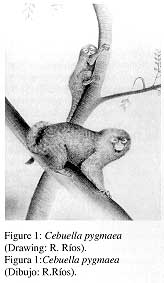 |
Pelage generally light brown to brownish-orange; hair fine, long and dense, especially on the head, neck, breast and arms. Back and forequarters orange-agouti-, lumbar region and legs light-brown; ventral part of body whitish-grey; anal area and basal parts of tail blackish; tail light brown with a small black terminal hair tuft. |
3. General information
C. pygmaea is the smallest of all monkeys, reaching
up to 15 cm head-body-length and weighing up to 150 g. Due to its small size,
it frequently remains undetected in its natural habitat.
It lives in alluvial forests and dense secondary vegetation with abundant lianas and vines, at a distance of generally no more than 50 m from the border of rivers. creeks, and lagoons. This habitat preference is probably due to the protection it offers against potential predators as well as to the abundance of insects and exudate sources. For travelling, foraging and resting, pygmy marmosets use the lowest strata of the forest. They sleep at the base of horizontal branches of bushes that are covered extensively by lianas and vines. Pygmy marmosets live in groups of up to 10 individuals, including the adult reproductive pair and its descendants of varying age (infants, juveniles, subadults, and young adults). There is no definite breeding season, but birth peaks occur in the middle and towards the end of the year. Normally twins are born, and the father is the principal carrier and protector of the infants. The diet is basically composed of exudates from the bark of trees and lianas, with Vochysia lomatophylla (Vochysiaceae; local name quillosisa) and Cedrela sp. (Meliaceae; local name cedro) being among the most important exudate sources. Trunks and lianas are perforated with small holes to stimulate the exudate flow. The diet also includes insects and sweet fruits.
Detailed information about the ecology, behaviour and population dynamics of pygmy marmosets is given by CASTRO & SOINI (1977), RAMIREZ et al. (1977), SNOWDON & HODUN (1981), SOINI (1982,1987a, 1988,1993), SOINI & SOINI (1990a), and SOINI et al. (1990).
4. Status
Being the only species whose populations do not suffer from the persecution by man, C. pygmaea is very common in Peruvian Amazonia. Until 1976 it had been considered as being endangered in Peru, due to its crypticity and difficulty to detect. The censuses and ecological studies conducted since 1976 indicate high population densities. Therefore, its current status is considered as COMMON.
5. Distribution, conservation and protection (Map 1)
HERSHKOVITZ (1977) mentions the basin of the upper Jurua in the Department of Ucayali and the basins of the rivers Tigre, Napo, Pastaza, Ucayali y Huallaga in the Department of Loreto. This distribution can be extended to the rivers Tahuamanú, Acre and Manú in the Department of Madre de Dios. It also reaches the lower parts of the Departments of Amazonas, San Martín, Huánuco, Pasco, Junín and Cusco. C. pygmaea is found in the Manú National Park, in the Pacaya-Samiria National Reserve and in the Comunal Reserve Tamshiyacu-Tahuayo.
B.) Saguinus fuscicollis Spix, 1823
1. Common name; local names
Saddle-back tamarin; Pichico, pichico barba blanca, pichico común.
2. External characters (Fig. 2)
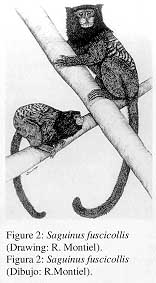 |
Coat generally with fine, dense and moderately long hair. Hair around mouth short and white; infants with a long white moustache which gets lost during the juvenile period. Black around eyes. Crown dark-agouti to black. Upperparts of trunk divided into three zones: mantle, saddle, and buttocks. Colour of mantle and buttock varies between blackish-agouti and caramel-brown, saddle greyish with orange or yellowish striations. Underparts dark-brown. Tail black. Further information is provided by HERSHKOVITZ (1977).
|
S. fuscicollis might be mistaken for S. mystax and S. nigricollis. The most conspicuous difference is the presence of a saddle in S. fuscicollis.
3. General information
Saddle-back tamarins are small-sized primates, reaching a
total length (head+body+tail) of 60 cm and weighing maximally 550 g. They live
in all types of forest and also in regenerating plantations (purmas). For
travelling, foraging and resting they use strata from the understory to the
medium canopy layers, but remain in the understory for most of the time. Frequently,
they descend to the forest floor in search of insects and fallen fruits. They
sleep in trees and bushes entangled by vines and in hollows of living and dead
trees. Groups consist of 2-20 individuals, with one reproductively active female,
one or several adult males and the offspring of variable age (infants to young
adults). Births occur with major frequency between December and February, coinciding
with the maximum abundance of fruits. Generally twins are born. The father and
other adult males are the principal caregivers of infants. The diet consists
of fruits, insects, gums, nectar and small vertebrates. In areas of sympatry
with other species of the genus Saguinus (S. mystax, S. labiatus or S.
imperator), interspecific associations between saddle-back tamarins and
one of these species are frequently observed.
Detailed information about the ecology, behaviour and population dynamics is found in BARTECKI & HEYMANN (1987a, 1990), CRANDLEMIRE-SACCO (1986,1988), GARBER(1986,1988a, 1988b, 1991,1993),GLANDER et. al. (1984), GOLDIZEN (1987a, 1987b, 1989), GOLDIZEN & TERBORGH (1986,1989) GOLDIZEN et al. (1988, in press), HEYMANN (1990a, 1990b), HODUN et al. (1981), JANSON et al. (1981), NORCONK (1986, 1990), PERES (1992a, 1992b, 1993), POOK & POOK,(1982), SNOWDON & SOINI (1988), SOINI (1981, 1987B), TERBORGH (1983), TERBORGH & GOLDIZEN (1985), TERBORGH & STERN (1987), and YONEDA (1981,1984a, 1984b).
4. Status
S. fuscicollis is one of the species whose populations
abound in Peruvian Amazonia. the numerous censuses carried out since 1972 indicate
that this species is very common. It seems to adapt easily to areas with human
influence and visits plantations to feed on bananas and other cultivated fruits.
Saddle-back tamarins are rarely hunted in areas with low human population density,
but hunting pressure is high in areas with high levels of deforestation and
exploitation through agriculture and cattle-ranging like in the areas of Alto
Mayo and Huallaga Central. The status is considered as COMMON.
5. Distribution, conservation and protection (Map 2)
HERSHKOVITZ (1977) considers the entire lowland Amazonia and parts of the lower selva alta (up to 1800 m a.s.l.) as the distributional range of saddle-back tamarins. Six subspecies are known from Peru. S. f leucogenys lives on the left bank of the Rio Huallaga, from the Marañón in the north southward to around the affluents of the Rio Pachitea in the Department of Pasco. S. f illigeri is distributed between the rivers Ucayali and Huallaga and between the Ucayali and Tapiche from their confluence, in the north to about 6º10'S in the south. S. f lagonotus lives north,of the Marañón, between the Rio Napo and the Rio Chinchipe. S. f nigrifrons lives on the right bank of the Ucayali and Amazonas. The distribution of S. f fuscicollis is restricted to the area between the rivers Tapiche and Blanco. S. f weddelli is found from the Rio Abujao southward to the Bolivian border.
S. fuscicollis is found the National Parks of Manú, Tingo Maria and Yanachaga-Chemillén, the National Reserve of Pacaya-Samiria, and the Comunal Reserve Tamshiyacu-Tahuayo. However, for the protection of all subspecies, new reserves should be established.
C.) Saguinus tripartitus Milan-Edwards, 1878
1. Common name; local names
Golden-mantle tamarin; Pichico barba blanca, pichico común.
2. External characters (Fig. 3)
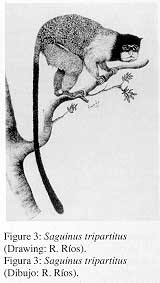 |
Similar to S. fuscicollis, but differing by the golden-orange colour of the mantle and forelimbs, and the black head. White, chevron-like patch on the midfrontal region. Further information is provided by HERSHKOVITZ (1977). |
3. General information
Size and weights similar to S. fuscicollis. These tamarins
live in primary, secondary and remnant forests, occupying lower parts (bajiales)
as well as high ground (bosque de colina). They use the lower and
middle layers of the forest for travelling, foraging and resting, and sleep
preferentially in bushes entangled with lianas and vines. Groups of 5-8 individuals
include an adult reproducing pair and its descendants of varying ages. The birth
season is not well defined, but on the Rio Curaray infants were observed between
October and January. The diet consists of fruits, insects and nectar, but the
consumption of cork from plants of the families Sapotaceae and Bombacaceae and
of dry rachises and folioles from ferns has also been observed. No ecological
and ethological studies of this species have been conducted so far.
4. Status
Until 1987 S. tripartitus was considered a subspecies of S. fuscicollis. After reviewing museum specimens and the field notes of Carlos Olalla, THORINGTON (1988) raised it to species rank. During explorations on the rivers Curaray and Napo in 1982 and 1989, several groups were observed, which might indicate its relative abundance. However, in the absence of detailed information about population densities the current status should be considered as INDETERMINATE.
5. Distribution, conservation and protection (Map 2)
HERSHKOVITZ (1977) and THORINGTON (1988) maintain that S.
tripartitus is distributed in northeastern Peru between the rivers Napo
and Putumayo and on the right bank of the lower Rio Napo. We have not observed
this species during explorations of the left-bank tributaries of the Rio Napo
between 1982 and 1989. Our only records are for the region between the rivers
Curaray and Napo. We conclude that the actual range of S. tripartitus is
much smaller than that given by the aforementioned authors.
This species is not included in any of the conservation areas. Its continued protection requires the establishment of a protected area between the rivers Napo and Curaray.
D.) Saguinus nigricollis Spix, 1823
1. Common name; local names
Black-mantle tamarin; Pichico, pichico barba blanca, pichico común.
2. External characters
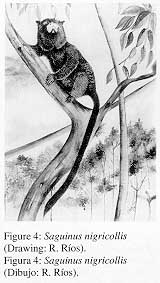 |
Coat generally dark, with fine, long, glossy hair. Skin around mouth darkly pigmented and with short whitish hair. Black around eyes and on crown, side of head dark brown. Dorsal and ventral parts of rump and forelimbs blackish, legs and base of tail reddish. Tail black. Further information is provided by HERSHKOVITZ (1977). |
There are few references to this species and it is little known from our region. It can be easily mistaken for S. fuscicollis and S. mystax. However, there are several characters to distinguish it unequivocally: from the former species by the lack of the saddle, from the latter species by the dark pigmentation of the skin around the mouth, although it is covered with short white hairs. Due to the possibility of confusion with S. fuscicollis and S. mystax, it is recommended that during faunal surveys special attention is paid to the differentiating characters, to define the limits of distribution of the respective species.
3. General information
With a length of up to 60 cm and a weight up 650 g, S. nigricollis belongs to the small-sized primates. It lives in primary, secondary and remnant forests and in regenerating plantations (purmas). For travelling, foraging and resting it prefers the lower and middle layers of the forest. It sleeps frequently in trees with abundant lianas which offer protection from adverse climatic conditions and from predators. Groups comprise 2-6 individuals. No birth season is apparent, but most births occur between October and January. Generally, twins are born which are carried and cared for by the father and older siblings. The few data available on its diet suggest similarity to S. fuscicollis. Locomotion is also similar to S. fuscicollis with short vertical leaps. Apart from the information provided by IZAWA (1978), no other ecological and behavioural studies of this species have been carried out.
4. Status
Results of surveys conducted by FREESE (1975) and NEVILLE (1977) indicate that population densities are relatively high. Hunting of this species is rare and it is frequently found close to cultivated areas. Its status is considered as COMMON.
5. Distribution, conservation and protection (Map 3)
HERSHKOVITZ (1977, 1982) presents a hypothetical distribution north of the rivers Marañón and Amazon till the right bank of the Rio Putumayo. During explorations carried out between 1981 and 1986 the species was not encountered in the basins of the rivers Tigre and Pastaza, but only up to the left bank of the Rio Nanay.
S. nigricollis is represented in Peru by the two subspecies S.n.nigricollis and S.n.graellsi. The former is more common and its distribution extends from the Rio Napo to the border of Ecuador, according to studies by Aquino based on collection on the Quebrada Yanayacu (Rio Napo) and direct observation of groups on the rivers Tambor and Santa María, tributaries to the left side of the Rio Napo. S. n. graellsi, lives on the right bank of the Rio Napo and on the left bank of the Rio Nanay, but its exact distribution is not yet known.
S. nigricollis is not found in any of the protected areas. A reserve between the rivers Napo and Putumayo should be established which would also include other species of primates as well as other animals native to this part of Amazonia.
E.) Saguinus mystax Spix, 1823
1. Common name; local names
Moustached tamarin; Pichico barba blanca, cervecero.
2. External characters (Plate I
|
Coat generally blackish with moderately long, fine, shiny hair. Black around eyes crown; skin of nose and around mouth unpigmented (flesh-coloured) with white hair that forms a well-developed moustache at the sides of the mouth. Back and inner side of limbs blackish-brown, outside blackish. Tail black. Further information is provided by HERSHKOVITZ (1977). |
3. General information
S. mystax is a small primate with a total length up
to 68 cm and a weight of 500-700 g. It lives in primary and secondary forests,
in forest patches, and in regenerating cultivations (purmas). Moustached
tamarins are typical representatives of the bosque de colina, but are
extremely rare in inundated forests. For travelling, foraging and resting all
layers of the forest are used, but the medium and lower strata are Preferred.
They rarely descend to the ground to consume fruits, to hunt insects, to eat
soil or to cross small clearings. They sleep in the forks of branches in trees
with ample crowns, between tangles of vines and lianas, and in palms. Groups
generally comprise 2- 10 individuals with one reproducing adult female, one
or several adult males and offspring of different ages. There is no well-defined
birth season, but most births occur between November and February. Generally,
twins are born which are carried and cared for by adult males and older siblings.
The diet consists basically of fruits, insects, gums and nectar. Moustached
tamarins are usually found in interspecific association with S. fuscicollis
nigrifrons or S. fuscicollis fuscicollis, although they use different
forest strata. Detailed information on the ecology and behaviour is provided
by CASTRO & SOINI (1977), GARBER (1986, 1988a, 198W 1989, 1991, 1993), GARBER
et al. (1984, 1993), GARBER, ENCARNACIÓN et al. (1993),
GAZZO (1985), GLANDER et al. (1984), HEYMANN (1987, 1990a, 1990b, 1990c, 1992,
in press), HEYMANN & HARTMANN (1991), NORCONK (1986, 1990), PERES (I 992a,
1992b, 1993), RAMIREZ (1984,1989), SNOWDON & HODUN (1985), and SOINI &
SOINI (090b).
4. Status
The censuses carried out by NEVILLE et al. (1976) and FREESE et al. (1982) indicate that S. mystax is very common. However, in areas like the basin of the river Tamshiyacu and the Quebrada Aucayo, close to Iquitos, a tendency towards local extinction can be stated as a consequence of intensive trapping, which has been perfected due to the high costs of hunting equipment. The status of this species is considered as COMMON.
5. Distribution, conservation and protection (Map 3)
Intensive censuses carried out between 1975 and.1986 indicate
that S. mystax is distributed from the right bank of the Rio Ucayali
in the west to the Rio Yavarí in the east and from the confluence of
the rivers Amazon and Yavarí in the north to approximately the Rio Sheshea
in the south; S. mystax is not found in the area between the rivers Ucayali
and Tapiche to about 06º10'S. HERSHKOVITZ (1977) also considers the area
between the rivers Marañón, Ucayali and Huallaga in the Department
of Loreto, and between the rivers Madre de Dios, Tahuamanú and Acre in
the Department Madre de Dios as part of the distributional range. During intensive
explorations in these river basins we have not found any evidence for the presence
of this species.
S. mystax is represented in Peru by the subspecies S. m. mystax. It is found in the Comunal Reserve Tamshiyacu-Tahuayo but in none of the other protected areas.
F.) Saguinus imperator E. Geoffroy, 1907
1. Common name; local names
Emperor tamarin; Pichico bigotudo, pichico cenizo, mono emperador.
2. External characters (Fig. 5)
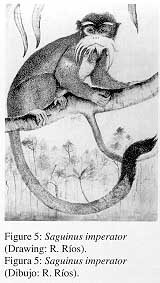 |
Coat generally greyish-brown, with shiny, fine and short hair. Subterminal band of hair golden or buffy. Forehead, brows and sides of face with a dark tone that contrasts with the silvery-brown crown. Skin of nose and around mouth unpigmented with white hair, forming an extremely long moustache at the side of the mouth;,moustache oriented downward or backward. Back and sides of rump greyish-brown. Underparts and limbs predominantly orange-brown. Tail reddish-orange with a grey tone. The two subspecies S. i. imperator and S. i. subgrisescens differ mainly in the orientation of the moustache: backwards in the former, downwards in the latter. Further information is provided by HERSHKOVITZ (1977, 1979a). |
3. General information
With a total length of up to 68 cm and a weight of 400-550
g, S. imperator belongs to the small primates. It lives principally in
primary and secondary forests of the bosque de colina type. Travelling,
foraging and resting generally take place in the lower and medium layers of
the forest. Groups comprise 3-8 individuals. They sleep in the forks of horizontal
branches or in tangles of vines and lianas located at the lower or middle parts
of the crown of medium-sized trees. The birth season is not well-defined, but
the majority of births is observed between October and December, coinciding
with the period of major fruit availability. Generally, twins are born which
are mainly carried and cared for by the adult male. As with other tamarin species,
the diet consists mainly of fruits, insects, and nectar. S. imperator is
normally found in interspecific association with S. Fuscicollis weddelli,
but they occupy different strata of the forest. Further information on ecology
and behaviour is provided by TERBORGH (1983).
4. Status
In our explorations between Iñapari and Iberia in the basin of the rivers Acre and Tahuamanu, we found this species relatively common, which may be attributed to its adaptability to secondary forests formed by abandoned and regenerating cultivations. It is common in the Man6 National Park (TERBORGH, 1983), but there is little information from other areas, e.g. for the rivers Tambo and Urubamba, Therefore, we consider its status as INDETERMINATE.
5. Distribution, conservation and protection (Map 3).
According to HERSHKOVITZ (1977, 1979a) S. imperator is distributed in southeastern Peru from the Rio Sheshea in the Department of Ucayali to the Bolivian border. It is represented in Peru by both subspecies, S. i. subgrisescens and S. i. imperator. The latter is probably restricted to the area between the rivers Tahuamanú and Acre.
G.) Saguinus labiatus E. Geoffroy, 1812
1. Common name; local names
Red-bellied tamarin, red-chested moustached tamarin; Pichico, pichico pecho anaranjado, huapito.
2. External characters (Fig. 6)
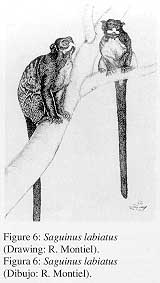 |
Coat with fine, short and shiny hair. Circumbuccal skin unpigmented (flesh-Coloured) with whitish hair forming a slightly developed moustache. Blackish around eyes and on crown; crown with a silvery triangular patch. Back and side of rump and outside of limbs dark-grey. Underparts and inner side of limbs orange-brown. Tail with short hair, dark-grey above and orange-brown below. Further information is provided by HERSHKOVlTZ (1977). |
3. General information
With a total length up to 65 cur and a weight up to 650 g,
S. labiatus belongs to the small primates. It lives in primary, secondary,
and remnant forests. Like S. mystax, it is a typical animal of the bosque
de colina. Travelling, foraging and resting take place in all layers of
the forest, although the upper and medium levels are used preferentially. It
sleeps on the forks of strong horizontal branches in trees with large crowns.
Groups contain 2-10 individuals. There is no particular birth season, but most
births occur between October and January during the period of major fruit availability.
Generally, twins are born which are carried and cared for by the adult male.
The diet consists basically of fruits and insects. Among insects, large orthopterans
living in the canes of pacales (associations of Guadua sp., Gramineae)
are preferred; therefore, S. labiatus is frequently encountered foraging
in this type of vegetation. They live in nearly permanent interspecific association
with S. Fuscicollis weddelli and are also temporally associated with
Callimico goeldii, although they occupy different layers of the forest.
Further information about ecology and behaviour is provided by BUCHANAN-SMITH
(1990,1991a, 1991b), POOK & POOK (.1982), and YONEDA (1981,,1984b).
4. Status
The results of censuses carried out by AQUINO & CASTRO (1988), CASTRO et. al. (1990), and ENCARNACIÓN & CASTRO (1990) indicate that the habitat of S. labiatus is very restricted, and has even drastically diminished in the last few years due to human activities. Since 198 1, the area with the highest population density has been clear-cut for human settlements, which represents a serious threat to the survival of this species in Peru. On the other hand, censuses were restricted to the south of the Iberia-Iñapari highway between the river Tahuamanú and Acre, but population densities to the north of the highway are unknown. Therefore, we consider the status of this species as INDETERMINATE
5. Distribution, conservation and protection (Map 3).
S. labiatus was reported in Peru for the first time in 1978,(see ENCARNACIÓN & CASTRO, 1990) and is represented by the subspecies S. L labiatus. According to these authors, it is distributed in the basins of the rivers Acre and Tahuamanú, with the,latter forming its southern limit. The western limit of distribution has still to be defined. S. labiatits is not included in any of the protected areas of Peru.
